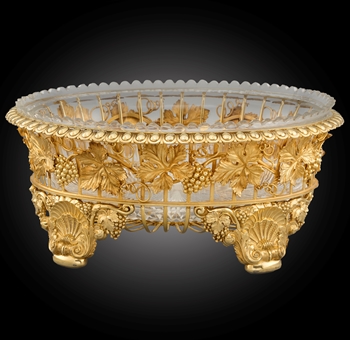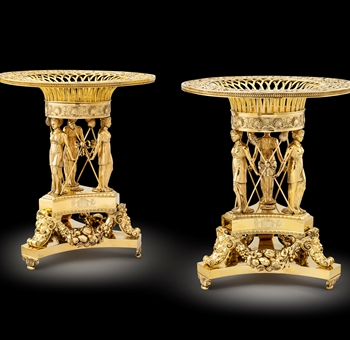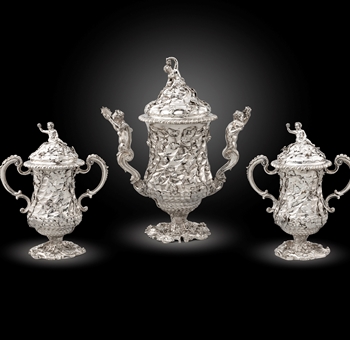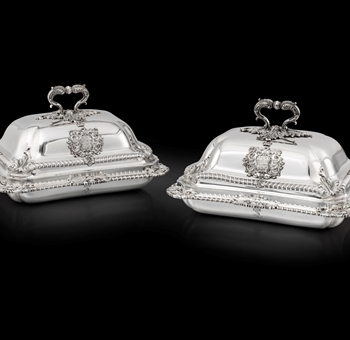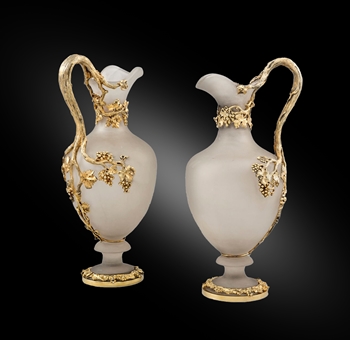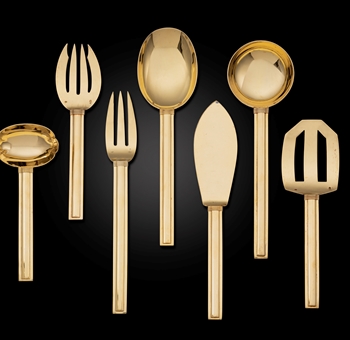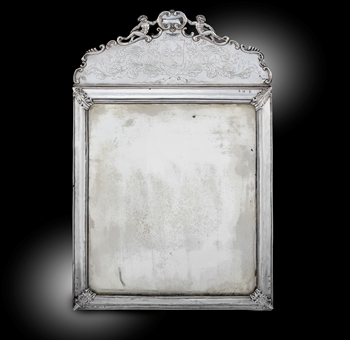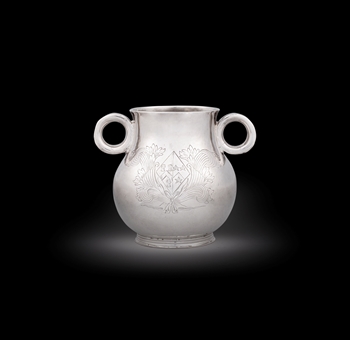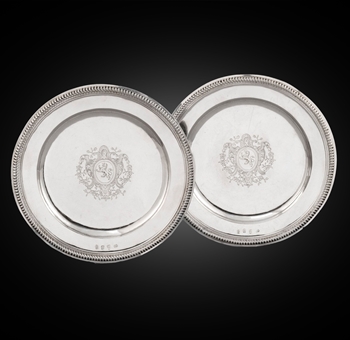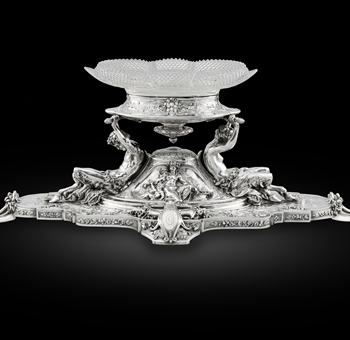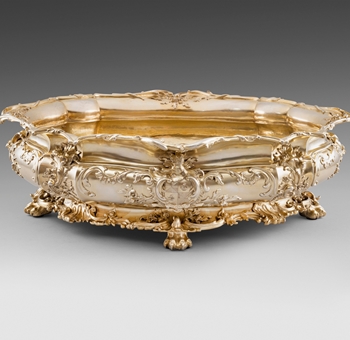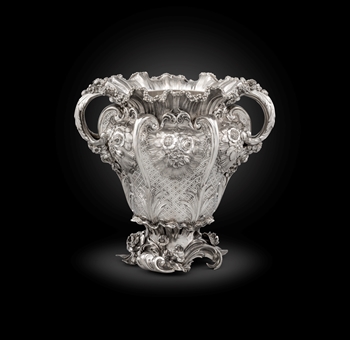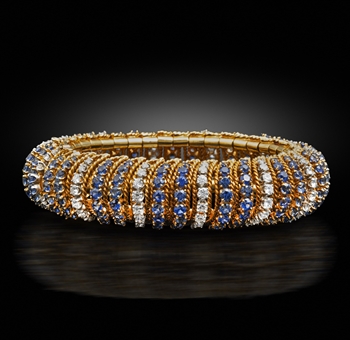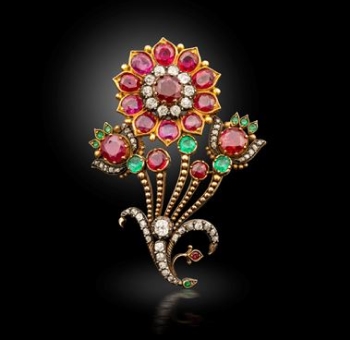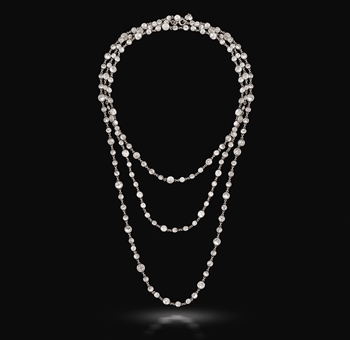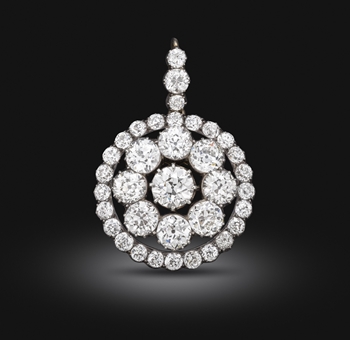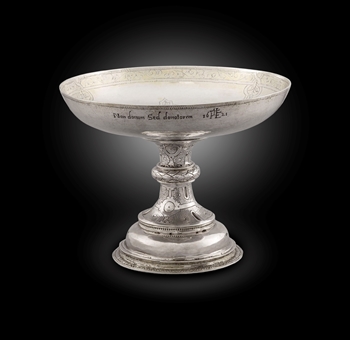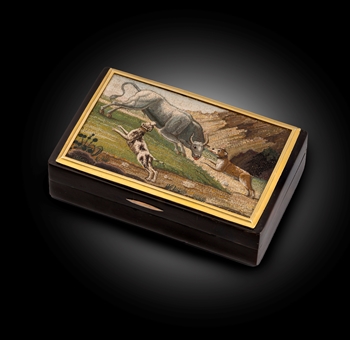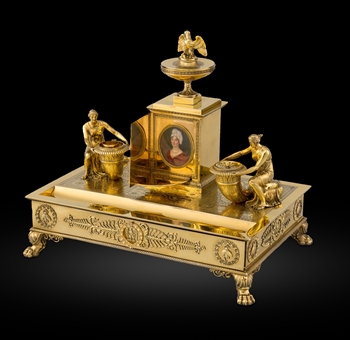 BACK TO LIST
BACK TO LIST
New Arrival at Koopman: A Pair of Monumental Silver-Gilt Sideboard Dishes by Paul Storr

A Monumental Pair of George III Silver-Gilt Sideboard Dishes, 1813
We are extremely excited to announce the return of two highly important objects to Koopman Rare Art. A pair of George III Silver-Gilt sideboard dishes by Paul Storr for Rundell, Bridge & Rundell after the design by Thomas Stothard. This pair of sideboard dishes are historically important both for their mastery of craftsmanship and reputable provenance.
Koopman Rare Art initially purchased the dishes from auction in 1984 at Sotheby’s, London (3rd May, ex-lot 105). The dishes at this date then entered the prestigious collection of His Excellency Mohammed Mahdi Al Tajir, before returning to Koopman this July, 2017.
Provenance
The dishes were first owned by William Pole-Tylney-Long-Wellesley of Wanstead House in Essex. A notorious scoundrel, gambler and fortune-seeker, he won the hand of Catherine Tylney-Long, the richest woman in England outside of royalty, with an income of £80,000 a year. The pair were married in 1812 and moved to Wanstead House in Essex. An extravagant entertainer Long-Wellesley held a grand fete in 1814 to celebrate the Duke of Wellington’s victory over Napoleon. It is likely that this pair of dishes were purchased specifically for this occasion.
In 1822, problems hit. Long-Wellesley was forced to mortgage Wanstead House in order to secure a debt of £250,000 and its contents to the creditors. The trustees of the settlement auctioned off the houses’ contents in an auction which lasted 32 days.

Rundell, Bridge & Rundell bought the dishes for Hugh Percy (1785-1847), 3rd Duke of Northumberland, whose arms were engraved on the reverse. The dishes stayed with the Percy family, until the Sotheby’s sale in 1984. Thirty-three years later and the monumental dishes are back with Koopman Rare Art.
This is the only pair from the series of ‘Bacchus and Ariadne’ sideboard dishes created by the workshop of Paul Storr for the Royal Goldsmiths Rundell, Bridge & Rundell. Two other single examples are known today. One created in 1814 was purchased by the Prince Regent, future King George IV, and is now held in the Royal Collection. Another example, which was part of the Audrey Love Collection was created in 1817. This later charger bears the arms of the 2nd Earl of Ailesbury.
 Detail of A Monumental & Highly Important Pair of George III Sideboard Dishes, Paul Storr (Westminster 1771 – Tooting 1844) after a design by Thomas Stothard (1755-1834)
Detail of A Monumental & Highly Important Pair of George III Sideboard Dishes, Paul Storr (Westminster 1771 – Tooting 1844) after a design by Thomas Stothard (1755-1834)
The centre of each dish is cast in bold relief with a group of Bacchus and Ariadne. Cherubs fly around their shoulders as they are drawn forward in an ornamental chariot by four centaurs who are wielding a thyrsus or playing a double-pie, a lyre and a tambourine. The dishes are further decorated with an applied ribbon-tied laurel wreath below a vine and trellis border. The border is strewn with cymbals and other antique musical instruments. The reverse of each dish is engraved with a coat-of-arms, supporters and motto below a duke’s coronet. They are both sorted in their original case with the brass plate engraved, ‘The Duke of Northumberland’.

Goldsmiths: Rundell, Bridge & Rundell
‘Massiveness … the principal characteristic of good plate’
Charles Heathcote Tatham (1772-1842) Architect and Designer, 1806
The Royal goldsmiths Rundell, Bridge & Rundell , were the largest and most successful supplier of plate, diamonds, pearls and jewellery of the period and drove the fashion for monumental silverware drawing on classical motifs from Greek and Roman architecture. To some extent, the success of Rundell, Bridge & Rundell boiled down to the sheer amount of expertise and creativity they had working with them. Rundell’s employed a number of talented artists to supply designs. John Flaxman (1755-1826) was particularly important. Flaxman was a sculptor whose most important work, arguably, is the silver-gilt Shield of Achilles created in 1821, now held in the Royal Collection.
Thomas Stothard (1755-1834) who designed the mythological scene for the dishes was another important member of the firm’s artistic circle. Stothard’s design for this pair of sideboard dishes was inspired by an antique Roman cameo discovered in the Via Aurelia in 1661, now in the Louvre having being seized by Napoleon in 1798.
Stothard was a painter, illustrator and engraver. He first entered the Royal Academy in 1778, where he gained full academician in 1794. Stothard admired the work of Rubens and this influence is evident in his small oil paintings. However, his strength was in illustration. His most important works included illustrations for The Pilgrim’s Progress in 1788 and Robinson Crusoe. His most famous painting is now held in the Tate Britain, The Pilgrimage to Canterbury painted between 1806-7.
 Thomas Stothard, The Pilgrimage to Canterbury, 1806-7, Oil on panel. Courtesy of the Tate Britain
Thomas Stothard, The Pilgrimage to Canterbury, 1806-7, Oil on panel. Courtesy of the Tate Britain
These works are available to view in our gallery located at Koopman Rare Art, The London Silver Vaults, 53/64 Chancery Lane, London, WC2A 1QS
For all enquiries please do not hesitate to call or email on:
0207 242 7624 / info@koopmanrareart.com




